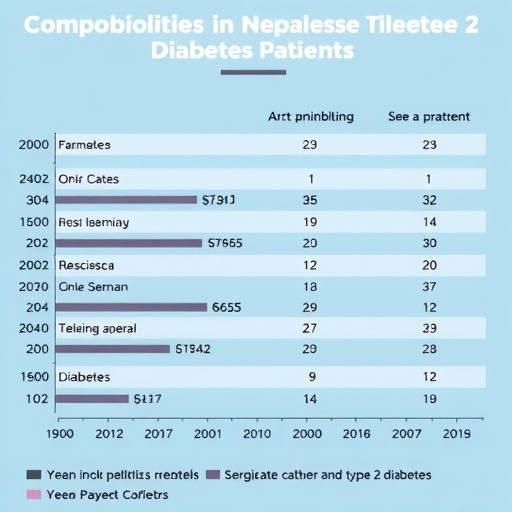In a ground-breaking study published in BMC Pediatrics titled “Predictors of recurrence and renal scarring post-urinary tract infection among young febrile infants,” researchers Tham, Ong, and Tan delve deep into the intricate dynamics between urinary tract infections (UTIs) and their long-term implications on pediatric health. The research specifically focuses on young febrile infants, a demographic often facing alarming consequences from UTIs that extend beyond immediate infections.
Urinary tract infections are surprisingly common among young children, particularly those who are febrile and under the age of two. These infections can lead to significant morbidity and potential long-lasting complications, such as renal scarring. Understanding the factors that contribute to the likelihood of recurrent infections or the development of renal scarring is critical for pediatric care providers. Researchers highlight that this vulnerable age group is at an especially high risk, underscoring the need for comprehensive research.
The study begins by asserting how febrile infants are particularly susceptible to UTIs due to a combination of anatomical, hormonal, and behavioral factors. The anatomical differences in the urinary tract of infants, for example, can create environments that are conducive to bacterial growth. This underscores the gravity of proper diagnosis and timely treatment which, if neglected, can lead to catastrophic outcomes such as kidney damage or systemic infections.
Tham and colleagues meticulously designed their research methodology, focusing on a cohort of febrile infants who presented with UTIs. By employing rigorous statistical analyses, they examined a breadth of biological and clinical factors to identify predictive markers that signal potential recurrence of infection and subsequent renal scarring. The approach is comprehensive, focusing not just on the mere presence of UTIs but extending the inquiry into genetic predispositions and environmental factors that could play contributing roles.
One striking aspect of the findings is the statistical correlation observed between initial UTI severity and the potential for subsequent renal complications. The study discovered that the higher the severity of the initial infection, the greater the likelihood of experiencing recurrent UTIs and renal scarring. This insight beckons a more prudent approach towards treating initial infections with an eye on preventing future complications.
Another relevant finding from the research highlights the role of gender in UTI recurrence rates. The data points to a statistically significant predisposition for boys versus girls in the context of febrile UTIs, adding a critical dimension to our understanding of how UTI manifestations may differ based on sex, alongside their consequent management in clinical settings.
Longitudinal data showcased in the study underscores the need for ongoing monitoring of infants who experience UTIs. Regular follow-ups can unveil patterns that may indicate developing complications, prompting health professionals to intervene proactively before irreversible damage occurs. The importance of parental education is also emphasized, particularly in recognizing signs and symptoms that could hint at a urinary tract anomaly or recurrent infection.
Moreover, the research discusses the contemporary technologies in diagnostics that could enhance early detection and management of these infections. For instance, innovative imaging techniques and biomarkers are emerging as invaluable tools that can aid pediatricians in differentiating between simple UTIs and those that may predispose a child to further complications. Such advancements highlight the importance of integrating technology into routine pediatric assessments.
One critical area of concern derived from this study is antibiotic resistance, a pervasive issue within the medical community. As UTIs become increasingly difficult to treat due to resistant strains of bacteria, understanding the predictors of recurrent infections may not only influence the choice of antibiotics but also guide preventative strategies in dealing with potential antibiotic resistance among children treated for UTIs.
While the study establishes significant predictors, it also raises key questions about future research avenues. For instance, could there be underlying genetic markers that predispose certain infants to recurrent UTIs? Addressing such questions is vital, as it would allow for personalized treatment options that go beyond the current one-size-fits-all approach in pediatric medicine.
In conclusion, the implications of Tham et al.’s research extend well beyond the immediate needs of treating UTIs in febrile infants. By uncovering predictors of recurrence and renal scarring, the authors lay the groundwork for an imperative shift in how pediatric healthcare providers approach urinary tract infections. Their findings promote awareness of the long-term ramifications of UTIs and encourage concerted efforts to establish comprehensive treatment protocols that not only treat but also preempt potential complications, thereby enhancing the overall wellbeing of affected infants.
As the landscape of pediatric healthcare evolves, the study stands as a testament to the intersection of research, clinical practice, and patient-centered care. The insights gleaned from this research herald a future where healthcare providers are equipped with deeper knowledge and tools to safeguard the health of young patients.
Subject of Research: Predictors of recurrence and renal scarring post-urinary tract infection among young febrile infants.
Article Title: Predictors of recurrence and renal scarring post-urinary tract infection among young febrile infants.
Article References:
Tham, K.W., Ong, I.Y.E., Tan, H.C. et al. Predictors of recurrence and renal scarring post-urinary tract infection among young febrile infants.
BMC Pediatr (2025). https://doi.org/10.1186/s12887-025-06322-z
Image Credits: AI Generated
DOI: 10.1186/s12887-025-06322-z
Keywords: urinary tract infections, febrile infants, renal scarring, recurrence, pediatric health, antibiotic resistance.
Tags: anatomy of infant urinary tractcomprehensive research on pediatric UTIsfebrile infants and UTIsinfant urinary tract infectionslong-term effects of urinary tract infectionsmorbidity associated with infant UTIspediatric health implications of UTIsprevention strategies for recurrent UTIs in infantsrecurrence of urinary tract infections in infantsrenal scarring after UTIsrisk factors for UTIs in young childrentimely treatment of UTIs in infants





